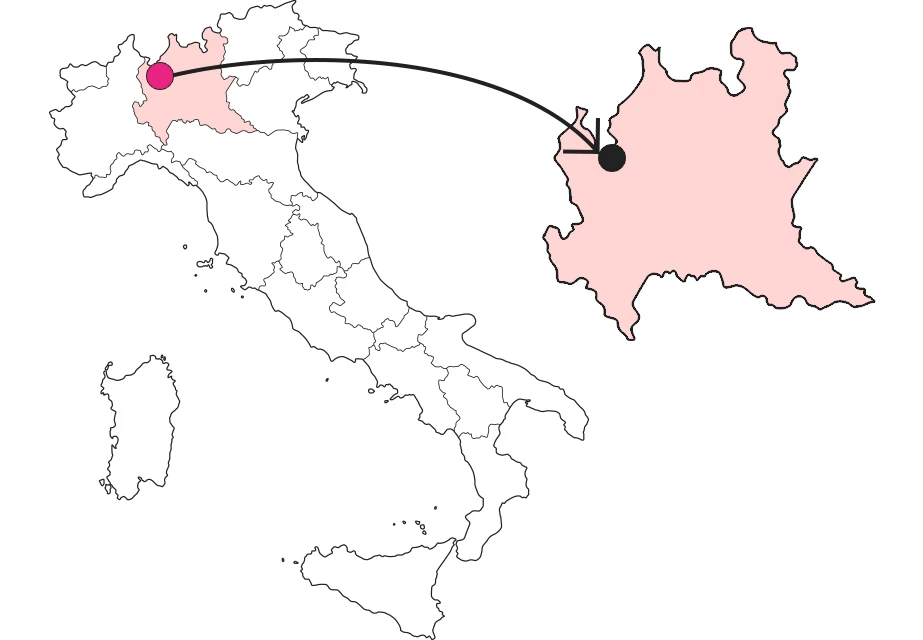














Where

The nights of the Intelvi Valley.
Night has engulfed Mount Generoso, and darkness and quiet reign over the entire Intelvi Valley. A few miles from the Swiss border, two men prepare for long hours of vigil. Both have a mission to complete before dawn. The first one wears jute-covered hiking boots, carries a heavy rectangular bag on his back, and drops of sweat bead his forehead despite the cold air. He proceeds at a plush, brisk pace, but freezes at every crackle, waits with bated breath, deciphering the noises in the darkness. Only when he feels safe does he resume the path.
The second man lies on a bunk in a tiny stone building, half stretched out and wrapped in a sheep's wool blanket. He wears a heavy gray jacket and holds against his chest a hat on which a yellow flame stands out. He does not look like someone who wants to sleep, and from the bottom of the blanket in fact sprouts a pair of reinforced boots. His ears tense at every slightest sound and his eyes scan the semi-darkness.
If they meet, it will be a defeat for the former. He will have to cut off the shoulder strap of his heavy bricolla, abandon it, and escape the worst by running through the woods. The second man knows his duty, but it will not be without a tinge of fear that he will leap up from his bunk and set off in pursuit into the darkness.
How many nights those two men, the burlanda and the sfrüsaduu, the financier and the smuggler, have chased, dodged, often feared, each other in those mountains. You can hear the stories of those nights, and of those years when smuggling on the Swiss border was the order of the day, at the Little Museum of the Guardia di Finanza and Smuggling.
 The night in Erbonne
The night in ErbonneThe village of Erbonne
We are in Erbonne, in the heart of the Intelvi Valley. The tiny mountain village, a handful of houses a few meters from the Swiss border, has a peculiar cross-border history. It has always been geographically Italian, but with an unclear legal and administrative status, at least until the mid-20th century. In fact, the rights to the village's land and farmsteads were owned by a Swiss family from Scudellate, across the border. This generated years of diatribes regarding the payment of taxes by the inhabitants, and it was not until after World War II that the legal status of the hamlet was clearly defined. Today, Erbonne's very few inhabitants, the majority of whom are Swiss nationals, pay taxes in Italy and the hamlet is a hamlet of Centro Valle Intelvi.
Smuggling
What made Erbonne famous, however, was above all its strategic location for smuggling traffic from Switzerland, especially in the period just after World War II, until the late 1970s. The smuggling of basic necessities such as coffee and sugar, but especially that of cigarettes, was so intense that the small Guardia di Finanza barracks were built in 1947.
The small barracks
Since then and for the next three decades the hamlet saw a succession of financiers from all over Italy, serving anti-smuggling duty day and night, and in all weathers. The barracks was closed in 1977, but through the initiative of the National Association of Financial Police, that date did not coincide with the end of its history. The A.N.F.I. Sezione Alceo Salvini, wanted to give back to the Intelvi Valley a living testimony to one of its important moments in history by restoring and refitting the small barracks. The structure, in a state of neglect until 2001, was transformed, and the following year the Small Museum of the Guardia di Finanza and Smuggling, christened "Burlanda e Sfrüsaduu," was born.
 Inside the museum
Inside the museumThe Museum
As if by magic, in the cramped space of the four walls of the little barracks, an immense world of memory and memorabilia now opens up, reconstructed thanks to, among others, contributions from the Historical Museum of the Guardia di Finanza in Rome and the Swiss Border Guard. There are also many private individuals who have contributed to the richness of the Little Museum, above all former smugglers and ex-financiers, living witnesses and narrators of a now distant but authentic history. In the museum we find many period objects, from the financier's sleeping bag (who often slept in the open), to the smuggler's tools (the bricolla and the sickle to cut his straps and facilitate his escape), to the old coat of arms of the Royal Guardia di Finanza, to period uniforms, both Italian and Swiss "colleagues."
Of symbols and memories
The Little Museum is not just a treasure chest of memories, it is an authentic place, it is special because it lives on through the people who wore those uniforms and slept in that bunk, with one eye open. It is a symbol, for those who lived through the era, of an attachment to the Guardia di Finanza corps that has perhaps been lost today, or at least, has turned into something else. In 2022 we celebrate 20 years since the opening of the Little Museum: this is a source of pride for all those who contributed to its creation and of great emotion for those who served in Erbonne and rediscover a piece of life, which has become the heritage of all.
Special thanks go to the protagonists of this story, to those who thought of and rebuilt this special place: Stefano Agnese, Gino Principessa, Angelo Serra, Pietro Vitelli, Guido D'Orazio, Ulderico Battista, Gabriele Lombardo and Piero Gammeri.
Enter the Map of Italy's Undiscovered Wonders and find treasures where you least expect it... Inspire, Recommend, Share...
Collections
It is part of the Land
The Map thanks:
In the Community
Enter the Map of Italy's Undiscovered Wonders and find treasures where you least expect it... Inspire, Recommend, Share...
Where

Collections
It is part of the Land



